Developmental finite element analysis of cichlid pharyngeal jaws: Quantifying the generation of a key innovation
- PMID: 29320528
- PMCID: PMC5761836
- DOI: 10.1371/journal.pone.0189985
Developmental finite element analysis of cichlid pharyngeal jaws: Quantifying the generation of a key innovation
Erratum in
-
Correction: Developmental finite element analysis of cichlid pharyngeal jaws: Quantifying the generation of a key innovation.PLoS One. 2018 Mar 29;13(3):e0195393. doi: 10.1371/journal.pone.0195393. eCollection 2018. PLoS One. 2018. PMID: 29596502 Free PMC article.
Abstract
Advances in imaging and modeling facilitate the calculation of biomechanical forces in biological specimens. These factors play a significant role during ontogenetic development of cichlid pharyngeal jaws, a key innovation responsible for one of the most prolific species diversifications in recent times. MicroCT imaging of radiopaque-stained vertebrate embryos were used to accurately capture the spatial relationships of the pharyngeal jaw apparatus in two cichlid species (Haplochromis elegans and Amatitlania nigrofasciata) for the purpose of creating a time series of developmental stages using finite element models, which can be used to assess the effects of biomechanical forces present in a system at multiple points of its ontogeny. Changes in muscle vector orientations, bite forces, force on the neurocranium where cartilage originates, and stress on upper pharyngeal jaws are analyzed in a comparative context. In addition, microCT scanning revealed the presence of previously unreported cement glands in A. nigrofasciata. The data obtained provide an underrepresented dimension of information on physical forces present in developmental processes and assist in interpreting the role of developmental dynamics in evolution.
Conflict of interest statement
Figures
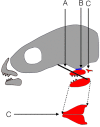
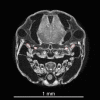
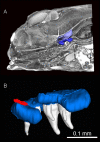
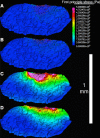
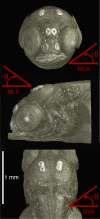


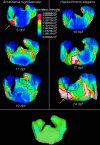

Similar articles
-
Embryonic development and skeletogenesis of the pharyngeal jaw apparatus in the cichlid Nile tilapia (Oreochromis niloticus).Anat Rec (Hoboken). 2009 Nov;292(11):1780-800. doi: 10.1002/ar.20960. Anat Rec (Hoboken). 2009. PMID: 19718717
-
Four-bar linkage modelling in teleost pharyngeal jaws: computer simulations of bite kinetics.J Anat. 2006 Jul;209(1):79-92. doi: 10.1111/j.1469-7580.2006.00551.x. J Anat. 2006. PMID: 16822272 Free PMC article.
-
Micro- and macroevolutionary decoupling of cichlid jaws: a test of Liem's key innovation hypothesis.Evolution. 2006 Oct;60(10):2096-109. Evolution. 2006. PMID: 17133866
-
Genetic and developmental basis of cichlid trophic diversity.Heredity (Edinb). 2006 Sep;97(3):211-21. doi: 10.1038/sj.hdy.6800864. Epub 2006 Jul 12. Heredity (Edinb). 2006. PMID: 16835594 Review.
-
Regulation and evolution of cardiopharyngeal cell identity and behavior: insights from simple chordates.Curr Opin Genet Dev. 2015 Jun;32:119-28. doi: 10.1016/j.gde.2015.02.008. Epub 2015 Mar 25. Curr Opin Genet Dev. 2015. PMID: 25819888 Free PMC article. Review.
Cited by
-
Correction: Developmental finite element analysis of cichlid pharyngeal jaws: Quantifying the generation of a key innovation.PLoS One. 2018 Mar 29;13(3):e0195393. doi: 10.1371/journal.pone.0195393. eCollection 2018. PLoS One. 2018. PMID: 29596502 Free PMC article.
-
The legacy and evolvability of Pere Alberch's ideas.Interface Focus. 2024 Oct 25;14(5):20240011. doi: 10.1098/rsfs.2024.0011. eCollection 2024 Oct 11. Interface Focus. 2024. PMID: 39464645 Free PMC article.
References
-
- Heegaard JH, Beaupré GS, Carter DR. Mechanically Modulated Cartilage Growth may Regulate Joint Surface Morphogenesis. J Orthop Res. 1999;17: 509–517. doi: 10.1002/jor.1100170408 - DOI - PubMed
-
- Elder SH, Kimura JH, Soslowsky LJ, Lavagnino M, Goldstein SA. Effect of compressive loading on chondrocyte differentiation in agarose cultures of chick limb-bud cells. J Orthop Res. 2000;18: 78–86. doi: 10.1002/jor.1100180112 - DOI - PubMed
-
- van der Meulen MCH, Huiskes R. Why mechanobiology? A survey article. J Biomech. 2002;35: 401–14. - PubMed
-
- Grad S, Eglin D, Alini M, Stoddart MJ. Physical stimulation of chondrogenic cells in vitro: a review. Clin Orthop Relat Res. 2011;469: 2764–72. doi: 10.1007/s11999-011-1819-9 - DOI - PMC - PubMed
-
- Wimberger PH. Plasticity of fish body shape. The effects of diet, development, family and age in two species of Geophugus (Pisces: Cichlidae). Biol J Linn Soc. 1992;45: 197–218.
Publication types
MeSH terms
LinkOut - more resources
Full Text Sources
Other Literature Sources

